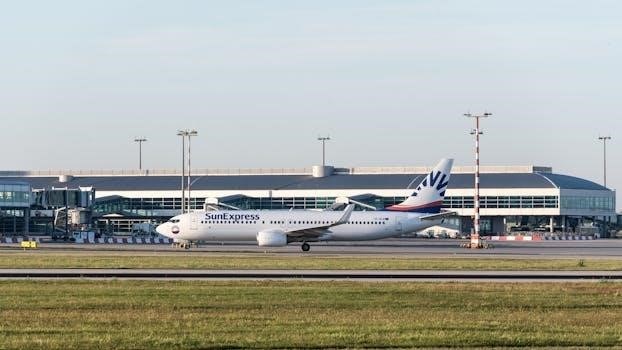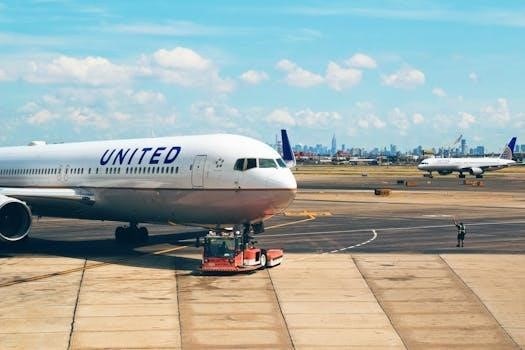Boeing Vacation Policy⁚ An Overview
Boeing offers paid time off (PTO) or separate vacation and sick leave. PTO allows accruing time-off hours in a single bank. Accrual rates increase with tenure. Employees can use PTO for vacation, personal time, or illness.

Paid Time Off (PTO) vs. Vacation and Sick Leave
Boeing utilizes both PTO and traditional vacation/sick leave policies. PTO combines vacation and sick time into a single accrual bank. Traditional policies offer separate allotments for vacation and sick leave, differing in usage.
Distinction between PTO and traditional vacation/sick leave policies.
The key difference lies in how time off is allocated and used. PTO merges vacation and sick days into one flexible bank, granting employees freedom to use it for any reason, be it illness, personal days, or holidays. Conversely, traditional policies segregate time off, designating specific amounts for vacation and sick leave. This separation restricts usage, requiring sick leave for illness and vacation time for leisure. PTO offers greater flexibility, while traditional policies provide structured allocation, impacting employee autonomy and usage patterns within Boeing.

PTO Accrual Rates
Boeing’s PTO accrual increases with time at the company. Longer tenure results in more PTO. Salaried, non-union employees accrue time off. This single bank of time can be used for any reason.
How PTO accrual increases with tenure at Boeing.
At Boeing, the rate at which employees accrue Paid Time Off (PTO) is directly linked to their length of service. As employees dedicate more years to Boeing, the amount of PTO they accumulate gradually increases. This system recognizes and rewards employee loyalty and commitment. The longer an individual remains employed at Boeing, the more PTO they will receive annually. This encourages employees to build a career with the company. It also ensures they have ample opportunity for rest, relaxation, and personal pursuits as their tenure grows.
PTO Usage
Boeing’s PTO policy offers flexibility. Employees can use accrued PTO for vacation, personal time, or sick leave. This provides control over time off, catering to individual needs and situations.
Flexibility in using PTO for vacation, personal time, or sick leave.
Boeing’s Paid Time Off (PTO) system is designed to provide employees with substantial flexibility in managing their time away from work. Unlike traditional systems that earmark specific days for vacation or sick leave, Boeing’s PTO allows employees to utilize their accrued time for various purposes. Whether it’s a planned vacation, attending to personal matters, or taking time off due to illness, the PTO system offers a single pool of hours to draw from. This flexibility empowers employees to balance their work and personal lives effectively, catering to their individual needs and circumstances without rigid constraints.
Vacation Time for New Hires
New, non-union Boeing hires accrue vacation time. They often start with around 10 vacation days. The accrual rate increases with years of service at the company.
Initial vacation days/hours for new, non-union hires.
Typically, new, non-union hires at Boeing can expect to receive a starting allocation of vacation time. This initial amount often translates to approximately 10 vacation days per year. However, the exact number of days or hours can vary based on the specific role, location, and employment agreement. New employees should consult their offer letter or HR to confirm their starting vacation accrual. Some reports indicate new hires can earn around 1.54 hours of vacation each week. This equates to roughly 80 hours, or ten days, annually.

Vacation Time for SPEEA Represented Engineers
SPEEA engineers’ vacation time increases with service years. They typically receive 12 vacation days initially, accruing weekly. At five years, accrual increases to 15 days annually, offering more time away.
Vacation accrual rates for SPEEA engineers, including increases with years of service.
For engineers represented by SPEEA, vacation accrual rates are determined by their years of service with Boeing. Typically, new SPEEA-represented engineers start with an initial vacation allotment, accruing time off on a weekly basis. The specific amount of vacation time earned per week will depend on their collective bargaining agreement and years of service. As their tenure increases, the accrual rate improves, leading to more vacation days annually. At milestones like five years, their vacation time increases providing more opportunities for rest and personal pursuits.
Benefits Package Overview
Boeing’s benefits package includes health & wellness programs, financial and retirement plans, and paid leave. Paid leave encompasses vacation, holidays, and sick leave. The package’s value is estimated at $18,324 per employee.
Components of the Boeing benefits package, including paid leave.
Boeing provides a comprehensive benefits package to its employees. This includes various components designed to support their well-being and financial security. Key elements of the package are insurance options, covering health, dental, and vision needs. Furthermore, Boeing offers robust health and wellness programs aimed at promoting employee health. Financial and retirement plans are also integral, assisting employees in planning for their future. Paid leave, encompassing vacation, holidays, and sick time, is another significant aspect. Other components include perks, discounts, transportation benefits, and tuition assistance.

Leave Service Center
Contact the Boeing Leave Service Center at 866-473-2016 for leave and disability inquiries. Select the leave of absence and disability option when prompted for assistance with your specific needs.
Contact information for the Boeing Leave Service Center.
For any inquiries related to leaves of absence or disability benefits, Boeing employees can contact the Boeing Leave Service Center. The center can be reached by calling Worklife at 866-473-2016. When prompted, select the option for leave of absence and disability to be directed to the appropriate representative. The Leave Service Center assists employees with understanding their leave options, initiating leave requests, and managing disability claims. They also provide guidance on using PTO or sick leave during waiting periods for disability benefits. Contact them for accurate and up-to-date information regarding Boeing’s leave policies.
Short-Term Disability (STD) and PTO
Boeing employees may use PTO to supplement Short-Term Disability (STD) benefits. This allows them to receive up to 100% of their regular pay during the STD waiting period, providing continued income support.
Using PTO to supplement STD benefits.
Boeing provides Short-Term Disability (STD) benefits to eligible employees, replacing a portion of their income when they are unable to work due to illness or injury. To ensure financial stability during the waiting period for STD benefits, employees can utilize their accrued Paid Time Off (PTO). By using PTO, employees can supplement their STD benefits to reach up to 100% of their regular pay. This integration of PTO with STD benefits offers a safety net, allowing employees to maintain their income while focusing on recovery and returning to work.
Global Paid Leave Policies
Boeing provides competitive benefits to employees globally, including paid leave and vacation. These policies apply to employees hired outside the United States who are part of a Boeing fully integrated subsidiary.
Overview of paid leave policies for employees outside the United States.
Boeing extends competitive benefits packages to its global workforce, encompassing comprehensive paid leave and vacation policies designed to cater to diverse employee needs. These policies, specifically tailored for employees hired and based outside the United States within fully integrated Boeing subsidiaries, reflect a commitment to work-life balance. The specifics of these paid leave arrangements, including accrual rates, usage guidelines, and eligibility criteria, are meticulously outlined in employee handbooks. These are designed to ensure clarity and accessibility for all international team members, adhering to local labor regulations and cultural nuances.